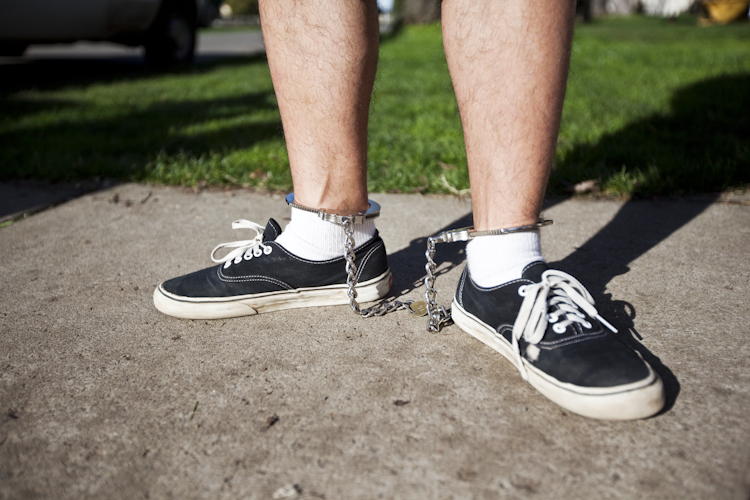
Richard Ross / www.juvenile-in-justice.com
From the Journal-News, Hamilton, Ohio / (MCT)
The American Civil Liberties Union of Ohio is asking the state’s highest court to stop the indiscriminate restraint of children in juvenile courts.
Restraining juveniles in court, without first having a hearing to determine if there is evidence to do so, is traumatizing and unconstitutional, the ACLU said in documents filed earlier this month.
“Forcing children to appear in court with restraints undermines the rehabilitative purpose of the juvenile court system,” the ACLU said in court documents. “Further, shackling is traumatizing to children, particularly if they have a history of emotional or physical abuse.”
The case stems from a Hamilton County case of a 14-year-old girl who appeared in court in leg shackles and handcuffs connected with a “belly belt” chain. A magistrate refused to remove the restraint when requested by the teen’s attorney, according to the ACLU. The girl is 5-feet-2-inches tall and was being held on non-violent drug charges that grew from her victimization as part of a human trafficking operation, according to court documents.
“The indiscriminate shackling of juveniles without first hold a hearing to determine the need to shackle that particular juvenile, violates the fifth, sixth and 14th Amendments the United States as well as …. to the Ohio Constitution,” according to the ACLU in court documents.
Shackling, which the ACLU defines as either handcuffs or leg chains, is a common practice for juvenile who are transported from Butler and Warren county detention centers for court appearances. Court officials say safety is the reason why.
Juveniles are led from the Butler County detention facility to magistrate’s or judge’s courtrooms in both hand and ankle restraints, but their hands are freed when they walk in. A court staff member sits directly behind the juvenile while in court to assure there is no misbehaving, according to Rob Clevenger, juvenile court administrator.
“Why do we do it? Safety and security,” Clevenger said, noting while the courtrooms do have bailiffs, they are unarmed.
The employees making the transports are also unarmed and are trained to verbally and physically defuse situations.
“I can tell you before we left the leg shackles on, we had a number of youth run and go off in the courtroom,” Clevenger said. One young man broke through a plate glass window in the court’s former facility at the Historic Courthouse. Another, who Clevenger personally caught, was able to get across the High/Main bridge before being apprehended.
The current practice was implemented in about 1991 when the juvenile facility was moved to the Fair Avenue site, and since then, there have been no escapes, Clevenger said.
“In a perfect world we would have court security in every courtroom. Emotions can run high in our courtrooms and things can go badly, quickly,” he said. “The measures we take are to prevent escape and protect youth from going off in the courtroom and hurting themselves and others.”
Juveniles in Warren county are restrained with handcuffs, leg chain and waist chains, said Tony Brigano, court administrator.
“That goes back three judges,” Brigano said. The youth incarcerated in the county juvenile detention center are transported through the same hallways as staff, so restraints are necessary for everyone’s safety, he said.
“You never know how impulsive people can be, especially children. And once they are out in the lobby area, they have direct access to the outside,” Brigano said. “We have the policy in place for a reason. But of course, we are sensitive to what the supreme court may do.”
Butler County Juvenile Court’s security plan as a whole is currently under review internally, and the timing of the court case could contribute to future decisions, Clevenger said.
Defense attorney Traci Combs-Valerio, who is assigned cases in Butler County Juvenile Court, said shackling of children is appropriate where the defendant is accused of highly violent charges.
“In some cases, it could be seen as cruel and unusual,” Combs-Valerio said.
Assessing restraint by looking at the history, age and even the size of the child is needed, she said.
“In certain cases, it is appropriate, but I do think there are cases where it could be considered overkill,” said Brad Kraemer, a defense attorney who recently defended a teen accused of trying to kill his parents by setting fire to their Liberty Twp. house.
“But it is a tough call to make a blanket rule,” he added.
ACLU attorney Jennifer Martinez Atzberger pointed to adult courts where defendants have the right to a hearing to determine if they should be shackled in court.
Typically, a defendant going to trial before a jury, is not restrained. If they are, the defense table is draped so that jurors can not see the shackles.
“For kids, the jury is the judge,” Martinez Atzberger said. “And there are some cases where restraints are warranted. We are not saying don’t restrain children, just make sure they are children who need to be restrained.”
———
©2014 the Journal-News (Hamilton, Ohio)
Visit the Journal-News (Hamilton, Ohio) at www.journal-news.com
Distributed by MCT Information Services
Of course, looking at it from the judge’s standpoint, using shackles on a case by case basis could also indicate to the bench that certain minors are more criminally inclined than others. A blanket policy allows the bench to see each defendant without that bias.
Didn’t Tiffany A. resolve this situation or was that only for California?